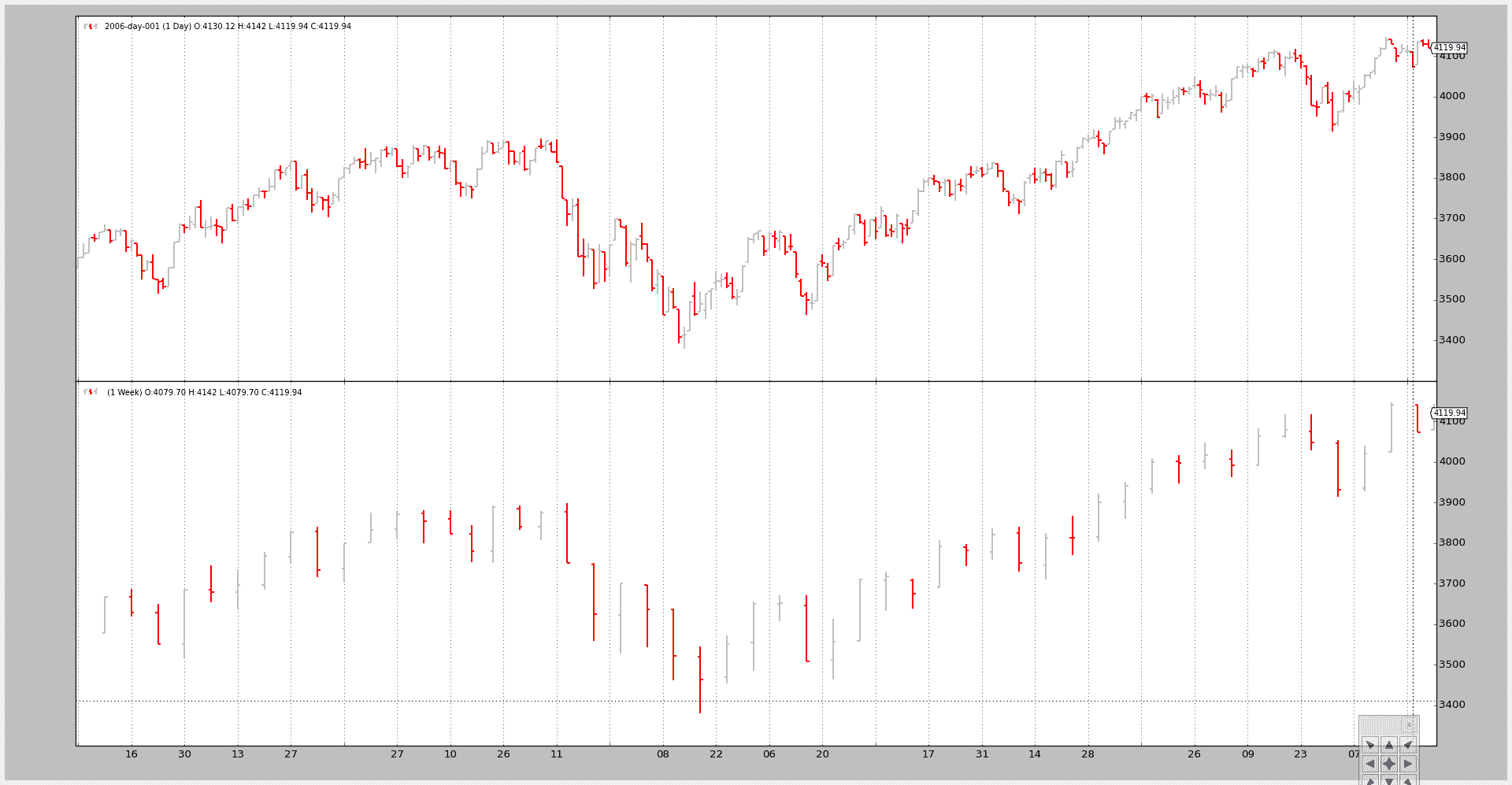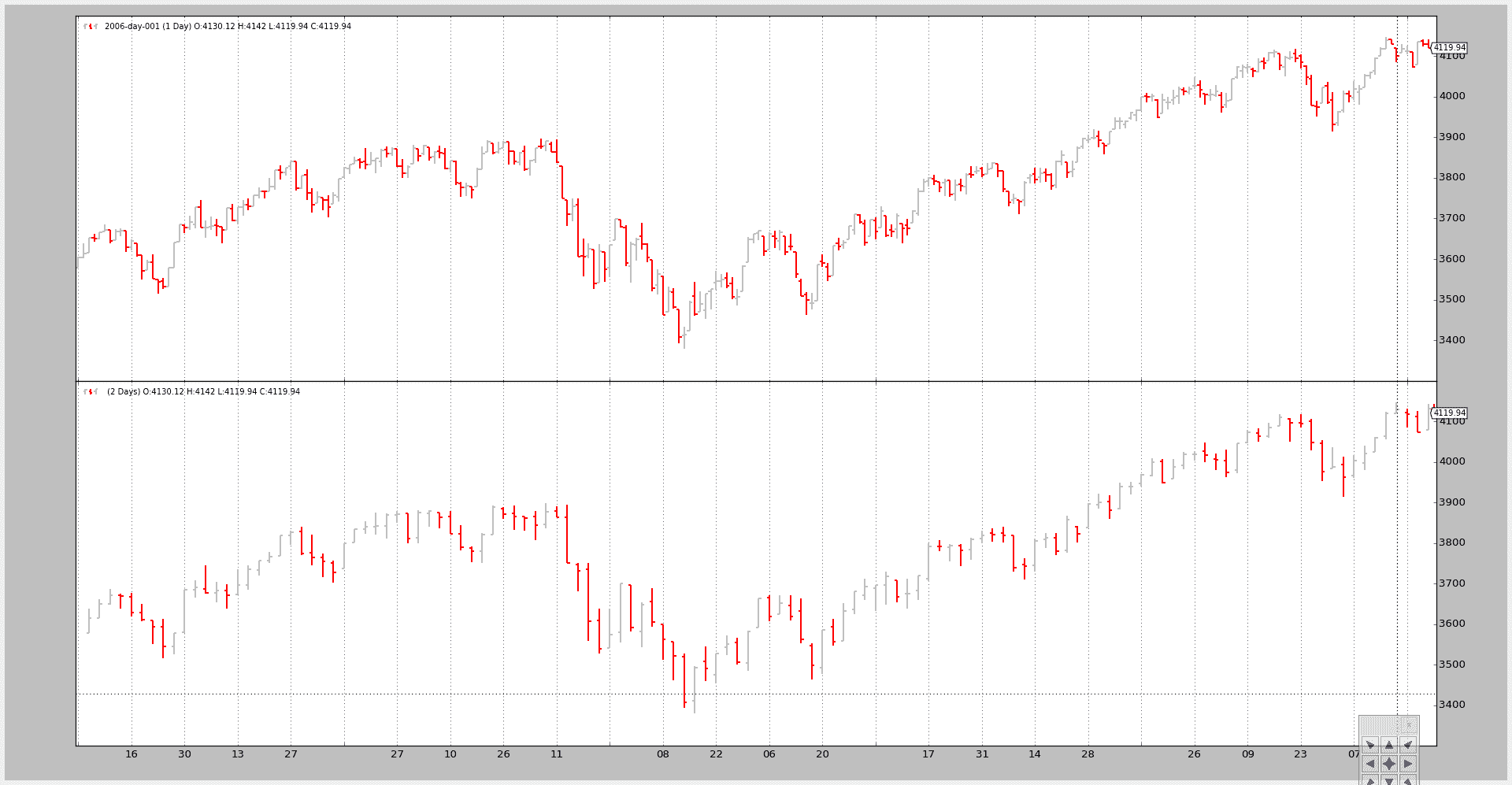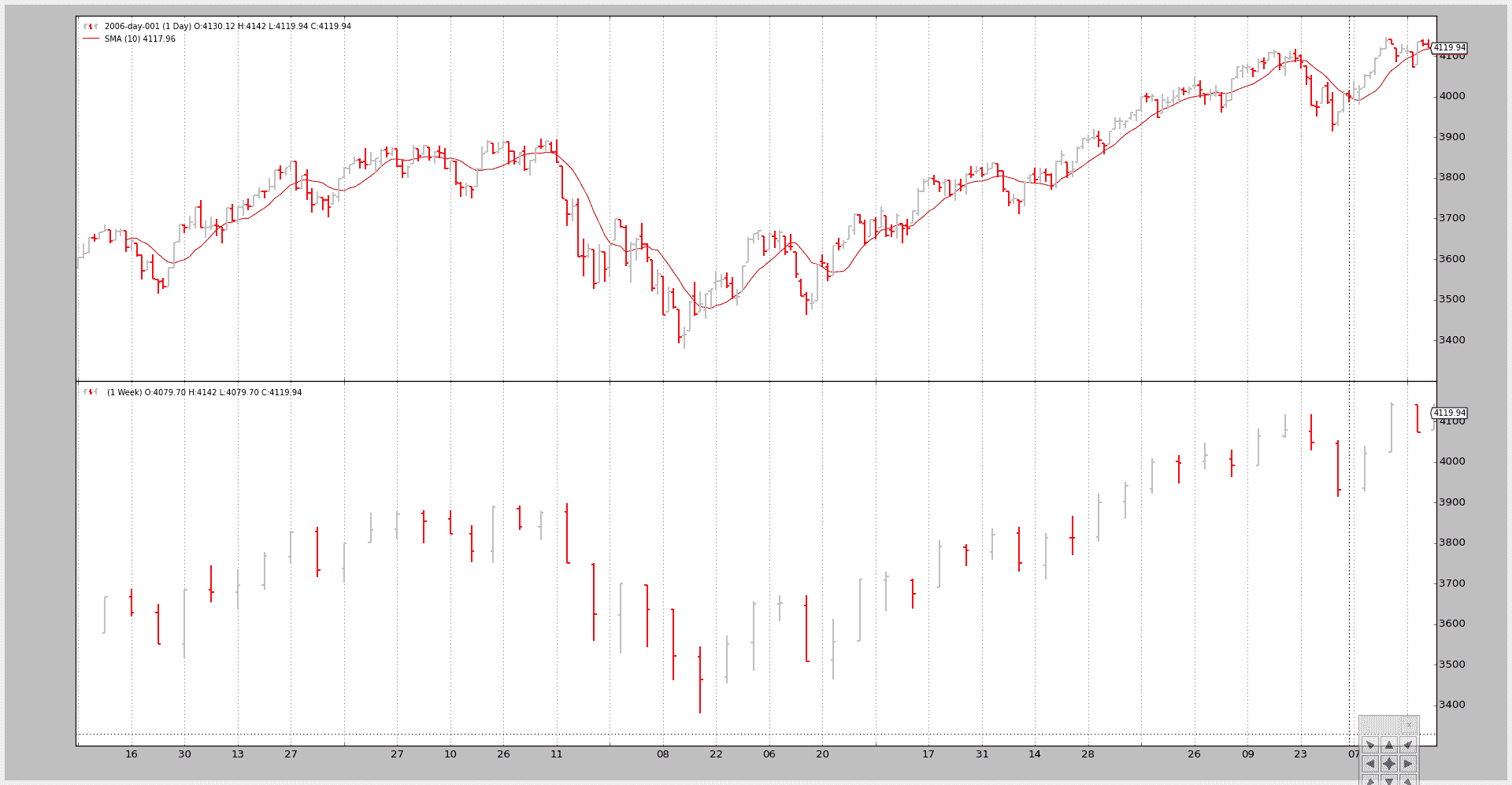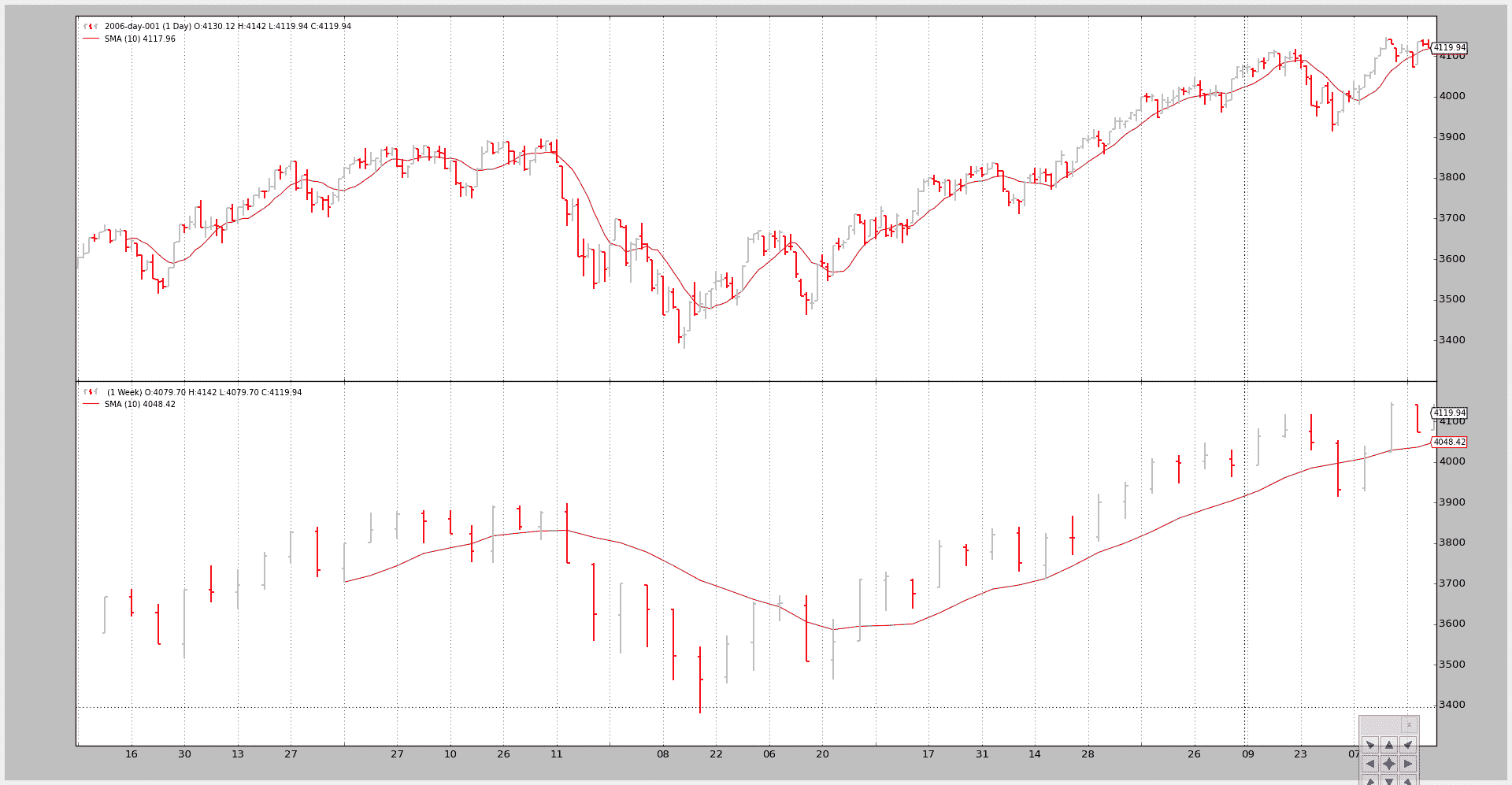数据-多个时间段
原文: https://www.backtrader.com/docu/data-multitimeframe/data-multitimeframe/
有时,投资决策采用不同的时间框架:
-
每周评估一次趋势
-
每日执行输入
或者 5 分钟对 60 分钟。
这意味着需要在backtrader中组合多个时间段的数据来支持这种组合。
对它的本机支持已经内置。最终用户只能遵守以下规则:
-
具有最小时间帧(因此条数较大)的数据必须是要添加到脑波实例的 1st数据
-
数据必须正确地与日期和时间对齐,平台才能从中获得任何意义
除此之外,最终用户可以在更短/更长的时间范围内自由应用所需的指标。当然:
- 适用于较大时间段的指标将产生较少的条带
该平台还将考虑以下内容
- 较大时间段的最短期限
最短时间段,可能会产生副作用,即在脑力图中添加的策略开始实施之前,必须消耗几个数量级的较小时间段。
内置的cerebro.resample将用于创建更大的时间范围。
下面是一些示例,但首先是测试脚本的要点。
# Load the Data
datapath = args.dataname or '../../datas/2006-day-001.txt'
data = btfeeds.BacktraderCSVData(dataname=datapath)
cerebro.adddata(data) # First add the original data - smaller timeframe
tframes = dict(daily=bt.TimeFrame.Days, weekly=bt.TimeFrame.Weeks,
monthly=bt.TimeFrame.Months)
# Handy dictionary for the argument timeframe conversion
# Resample the data
if args.noresample:
datapath = args.dataname2 or '../../datas/2006-week-001.txt'
data2 = btfeeds.BacktraderCSVData(dataname=datapath)
# And then the large timeframe
cerebro.adddata(data2)
else:
cerebro.resampledata(data, timeframe=tframes[args.timeframe],
compression=args.compression)
# Run over everything
cerebro.run()
步骤如下:
-
加载数据
-
根据用户指定的参数对其重新采样
该脚本还允许加载 2nd数据
-
将数据添加到大脑
-
将重新采样的数据(较大的时间段)添加到大脑中
-
跑
示例 1-每日和每周
脚本的调用:
$ ./multitimeframe-example.py --timeframe weekly --compression 1
以及输出图表:
示例 2-每日和每日压缩(2 巴至 1 巴)
脚本的调用:
$ ./multitimeframe-example.py --timeframe daily --compression 2
以及输出图表:
示例 3-具有 SMA 的策略
虽然绘图很好,但这里的关键问题是显示更大的时间范围如何影响系统,特别是当它涉及到起点时
脚本可以采用--indicators添加策略,在较小的时间段数据上创建周期 10的简单移动平均值。
如果只考虑较小的时间范围:
-
next将在 10 条之后首先调用,这是简单移动平均线产生值所需的时间注意:请记住,策略监视器创建了指标,只有在所有指标都产生了值时才调用
next。其基本原理是,最终用户已添加指标,以便在逻辑中使用它们,因此,如果指标未产生任何值,则不应发生逻辑
但在这种情况下,较大的时间段(每周)延迟调用next,直到每周数据的简单移动平均值产生一个值,这需要……10 周。
脚本覆盖了只调用一次的nextstart,默认调用next以显示首次调用的时间。
调用 1:
只有较小的时间段(每天)得到一个简单的移动平均线
命令行和输出
$ ./multitimeframe-example.py --timeframe weekly --compression 1 --indicators --onlydaily
--------------------------------------------------
nextstart called with len 10
--------------------------------------------------
还有图表。
第 2 段:
两个时间段都有一个简单的移动平均线
命令行:
$ ./multitimeframe-example.py --timeframe weekly --compression 1 --indicators
--------------------------------------------------
nextstart called with len 50
--------------------------------------------------
--------------------------------------------------
nextstart called with len 51
--------------------------------------------------
--------------------------------------------------
nextstart called with len 52
--------------------------------------------------
--------------------------------------------------
nextstart called with len 53
--------------------------------------------------
--------------------------------------------------
nextstart called with len 54
--------------------------------------------------
这里需要注意两件事:
-
策略不是在10时段后调用,而是在 50 时段后调用 1st。
之所以如此,是因为在较大(每周)时间范围内应用的简单移动平均线在 10 周后产生一个值……即
10 weeks * 5 days / week … 50 days -
nextstart被叫了 5 次而不是 1 次。这是一个自然的副作用,混合了时间框架,并将(在本例中只有一个)指标应用于更大的时间框架。
较大的时间段简单移动平均线产生 5 倍相同的值,同时每天消耗 5 条。
由于周期的开始由更大的时间段控制,因此
nextstart被调用了 5 次。
还有图表。
结论
在backtrader中可以使用多个时间段数据,无需特殊对象或调整:只需先添加较小的时间段即可。
测试脚本。
from __future__ import (absolute_import, division, print_function,
unicode_literals)
import argparse
import backtrader as bt
import backtrader.feeds as btfeeds
import backtrader.indicators as btind
class SMAStrategy(bt.Strategy):
params = (
('period', 10),
('onlydaily', False),
)
def __init__(self):
self.sma_small_tf = btind.SMA(self.data, period=self.p.period)
if not self.p.onlydaily:
self.sma_large_tf = btind.SMA(self.data1, period=self.p.period)
def nextstart(self):
print('--------------------------------------------------')
print('nextstart called with len', len(self))
print('--------------------------------------------------')
super(SMAStrategy, self).nextstart()
def runstrat():
args = parse_args()
# Create a cerebro entity
cerebro = bt.Cerebro(stdstats=False)
# Add a strategy
if not args.indicators:
cerebro.addstrategy(bt.Strategy)
else:
cerebro.addstrategy(
SMAStrategy,
# args for the strategy
period=args.period,
onlydaily=args.onlydaily,
)
# Load the Data
datapath = args.dataname or '../../datas/2006-day-001.txt'
data = btfeeds.BacktraderCSVData(dataname=datapath)
cerebro.adddata(data) # First add the original data - smaller timeframe
tframes = dict(daily=bt.TimeFrame.Days, weekly=bt.TimeFrame.Weeks,
monthly=bt.TimeFrame.Months)
# Handy dictionary for the argument timeframe conversion
# Resample the data
if args.noresample:
datapath = args.dataname2 or '../../datas/2006-week-001.txt'
data2 = btfeeds.BacktraderCSVData(dataname=datapath)
# And then the large timeframe
cerebro.adddata(data2)
else:
cerebro.resampledata(data, timeframe=tframes[args.timeframe],
compression=args.compression)
# Run over everything
cerebro.run()
# Plot the result
cerebro.plot(style='bar')
def parse_args():
parser = argparse.ArgumentParser(
description='Multitimeframe test')
parser.add_argument('--dataname', default='', required=False,
help='File Data to Load')
parser.add_argument('--dataname2', default='', required=False,
help='Larger timeframe file to load')
parser.add_argument('--noresample', action='store_true',
help='Do not resample, rather load larger timeframe')
parser.add_argument('--timeframe', default='weekly', required=False,
choices=['daily', 'weekly', 'monhtly'],
help='Timeframe to resample to')
parser.add_argument('--compression', default=1, required=False, type=int,
help='Compress n bars into 1')
parser.add_argument('--indicators', action='store_true',
help='Wether to apply Strategy with indicators')
parser.add_argument('--onlydaily', action='store_true',
help='Indicator only to be applied to daily timeframe')
parser.add_argument('--period', default=10, required=False, type=int,
help='Period to apply to indicator')
return parser.parse_args()
if __name__ == '__main__':
runstrat()





